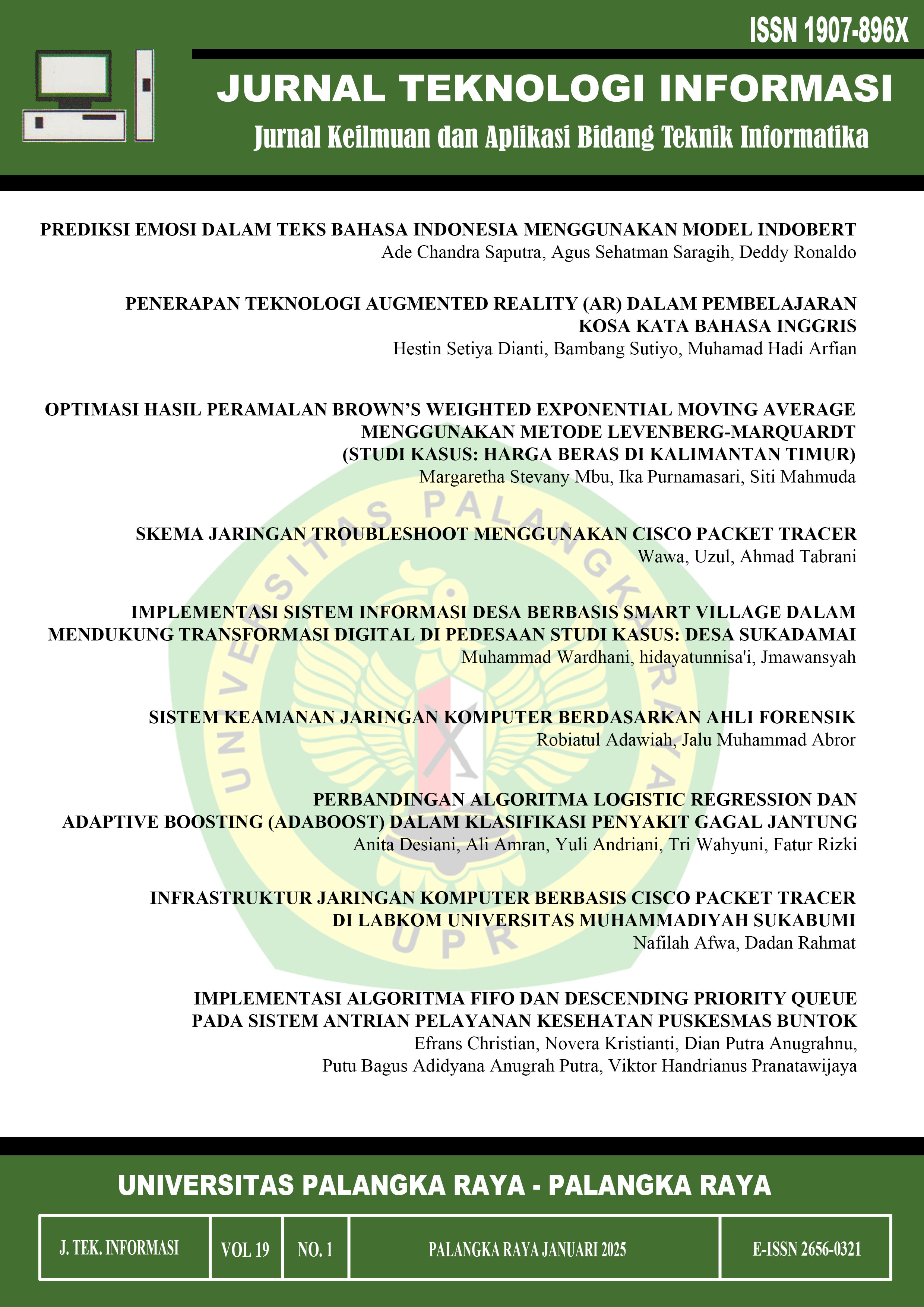PERBANDINGAN ALGORITMA LOGISTIC REGRESSION DAN ADAPTIVE BOOSTING (ADABOOST) DALAM KLASIFIKASI PENYAKIT GAGAL JANTUNG
Keywords:
Heart Failure, Logistic Regression, AdaboostAbstract
The heart is a vital organ in the human body, responsible for pumping blood throughout the body via the circulatory system. The heart is responsible for the delivery of oxygen and nutrients to tissues, as well as the removal of carbon dioxide and other waste products. Any disruption to the heart's functioning has the potential to be fatal to human survival. One such disruption is heart failure disease, also known as congestive heart failure (CHF). It is of the utmost importance to detect heart failure at an early stage. The early detection of heart failure disease can be achieved through the utilisation of machine learning, which can mitigate the low probability of this disease. This research employs a machine learning system based on artificial intelligence, utilising logistic regression and adaptive boosting (adaboost) algorithms. The research findings indicate that the classification of heart failure can be accurately determined using a range of parameters. The highest accuracy results, derived from this study, are 90% accuracy, 84% precision, 88% recall, and 88% F1-score. These results are exclusively attributable to the adaboost algorithm. In comparison to the logistic regression algorithm, the resulting accuracy is still below that of the adaboost algorithm, with the results being 86% accuracy, 76% precision, 79% recall, and 88% F1-score. It can therefore be concluded that the adaboost algorithm is more effective than the logistic regression algorithm in classifying heart failure disease. This is particularly the case when the selected data set exhibits an unbalanced number of labels.
Downloads
References
U. Basuki, “Merunut Konstitusionalisme Hak Atas Pelayanan Kesehatan Sebagai Hak Asasi Manusia,” J. Huk. Caraka Justitia, vol. 1, no. 1, pp. 21–41, 2020, [Online]. Available: https://ejournal.up45.ac.id/index.php/JHCJ/article/view/699
M. Hutasuhut, T. Tugiono, and A. H. Nasyuha, “Analisis Aritmia (Gangguan Irama Jantung) Menerapkan Metode Certainty Factor,” J. Media Inform. Budidarma, vol. 5, no. 4, p. 1386, 2021, doi: 10.30865/mib.v5i4.3289.
E. Tasia, R. Zaid, I. Zarier, S. Kenia, and P. Loka, “Klasifikasi Penyakit Gagal Jantung Menggunakan Supervised Learning,” Sentimas, pp. 1–7, 2023, [Online]. Available: https://journal.irpi.or.id/index.php/sentimas/article/view/535
Eva Miranda Marwali, Yoel Purnama, and Poppy Surwianti Roebiono, “Modalitas Deteksi Dini Penyakit Jantung Bawaan di Pelayanan Kesehatan Primer,” J. Indones. Med. Assoc., vol. 71, no. 2, pp. 100–109, 2021, doi: 10.47830/jinma-vol.71.2-2021-241.
J. J. Pangaribuan, H. Tanjaya, and K. Kenichi, “Mendeteksi Penyakit Jantung Menggunakan Machine Learning Dengan Algoritma Logistic Regression,” J. Inf. Syst. Dev., vol. 06, no. 02, pp. 1–10, 2021.
W. Lestari and S. Sumarlinda, “Studi Komparatif Model Klasifikasi Kerentanan Penyakit Jantung Menggunakan Algoritma Machine Learning,” SATIN - Sains dan Teknol. Inf., vol. 9, no. 1, pp. 107–115, 2023, doi: 10.33372/stn.v9i1.918.
Q. R. Cahyani et al., “Prediksi Risiko Penyakit Diabetes menggunakan Algoritma Regresi Logistik Diabetes Risk Prediction using Logistic Regression Algorithm Article Info ABSTRAK,” JOMLAI J. Mach. Learn. Artif. Intell., vol. 1, no. 2, pp. 2828–9099, 2022, doi: 10.55123/jomlai.v1i2.598.
L. Anisa and N. A. K. Rifai, “Analisis Regresi Logistik Biner dengan Metode Penalized Maximum Likelihood pada Penyakit Covid-19 di RSUD Pringsewu,” J. Ris. Stat., vol. 2, no. 2, pp. 129–136, 2022, doi: 10.29313/jrs.v2i2.1425.
D. Y. Wulandari, Ismaraidha, and O. Amelia, “Analisis Model Regresi Logistik Biner Dalam Menentukan Faktor-Faktor yang Mempengaruhi Masa Studi Mahasiswa,” J. Math. Educ. Sci., vol. 8, no. 1, pp. 127–134, 2022.
A. A. Lestari, L. C. Agatha, A. Desiani, F. Matematika, and P. Alam, “Analisis Perbandingan Klasifikasi Penyakit Jantung Menggunakan Algoritma Naïve Bayes dan Algoritma Logistic Regression,” vol. 5, no. 2, pp. 82–90.
A. S. Prabowo and F. I. Kurniadi, “Analisis Perbandingan Kinerja Algoritma Klasifikasi dalam Mendeteksi Penyakit Jantung,” J. SISKOM-KB (Sistem Komput. dan Kecerdasan Buatan), vol. 7, no. 1, pp. 56–61, 2023, doi: 10.47970/siskom-kb.v7i1.468.
A. M. Majid and M. N. Dwi Miharja, “Penerapan Metode Discretization Dan Adaboost Untuk Meningkatkan Akurasi Algoritma Klasifikasi Dalam Memprediksi Penyakit Jantung,” Indones. J. Bus. Intell., vol. 5, no. 2, p. 70, 2022, doi: 10.21927/ijubi.v5i2.2689.
Y. Crismayella, N. Satyahadewi, and H. Perdana, “Algoritma Adaboost pada Metode Decision Tree untuk Klasifikasi Kelulusan Mahasiswa,” Jambura J. Math., vol. 5, no. 2, pp. 278–288, 2023, doi: 10.34312/jjom.v5i2.18790.
A. Siraj, R. Waluyo, J. Letjend, P. Soemarto, K. P. Utara, and K. Banyumas, “Optimasi Prediksi Kematian pada Gagal Jantung : Analisis Perbandingan Algoritma Pembelajaran Ensemble dan Teknik Penyeimbangan Data pada Dataset Optimizing Heart Failure Mortality Prediction : Comparative Analysis of Ensemble Learning Algorithms and Data ,” vol. 12, no. 2, pp. 365–372, 2024, doi: 10.26418/justin.v12i2.75158.
T. A. E. Putri, T. Widiharih, and R. Santoso, “Penerapan Tuning Hyperparameter Randomsearchcv Pada Adaptive Boosting Untuk Prediksi Kelangsungan Hidup Pasien Gagal Jantung,” J. Gaussian, vol. 11, no. 3, pp. 397–406, 2023, doi: 10.14710/j.gauss.11.3.397-406.
Larxel, “Heart Failure Prediction.” [Online]. Available: https://www.kaggle.com/andrewmvd/heart-failure-clinical-data%0A%0A
Wiwid Wahyudi, “Implementasi Data Mining Untuk Klasifikasi Penyakit Liver Dengan C4.5 Adaboost,” J. Ilm. Tek. Inform. dan Komun., vol. 1, no. 3, pp. 71–76, 2021, doi: 10.55606/juitik.v1i3.120.












